2022 TOYOTA SUPRA child restraint
[x] Cancel search: child restraintPage 139 of 498
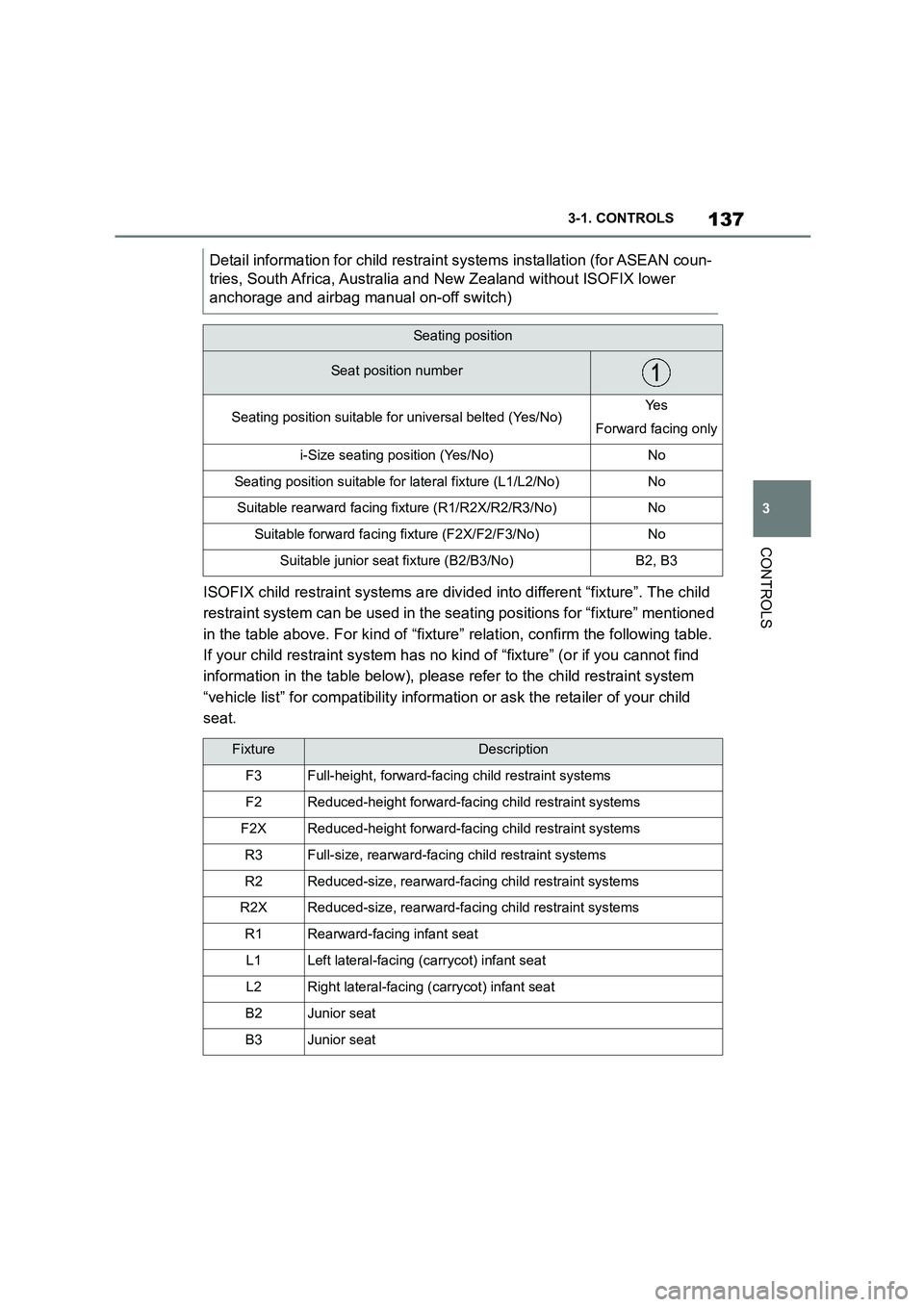
137
3
3-1. CONTROLS
CONTROLS
ISOFIX child restraint systems are divid ed into different “fixture”. The child
restraint system can be used in the se ating positions for “fixture” mentioned
in the table above. For kind of “fixtu re” relation, confirm the following table.
If your child restraint system has no ki nd of “fixture” (or if you cannot find
information in the table below), please refer to the child restraint system
“vehicle list” for compatib ility information or ask the retailer of your child
seat.
Detail information for chil d restraint systems installation (for ASEAN coun-
tries, South Africa, Australia and New Zealand without ISOFIX lower
anchorage and airbag manual on-off switch)
Seating position
Seat position number
Seating position suitable for universal belted (Yes/No)Ye s
Forward facing only
i-Size seating position (Yes/No)No
Seating position suitable for lateral fixture (L1/L2/No)No
Suitable rearward facing fixture (R1/R2X/R2/R3/No)No
Suitable forward facing fixture (F2X/F2/F3/No)No
Suitable junior seat fixture (B2/B3/No)B2, B3
FixtureDescription
F3Full-height, forward-faci ng child restraint systems
F2Reduced-height forward-facing child restraint systems
F2XReduced-height forward-facing child restraint systems
R3Full-size, rearward-facing child restraint systems
R2Reduced-size, rearward-facing child restraint systems
R2XReduced-size, rearward-facing child restraint systems
R1Rearward-facing infant seat
L1Left lateral-facing (carrycot) infant seat
L2Right lateral-facing (carrycot) infant seat
B2Junior seat
B3Junior seat
Page 140 of 498
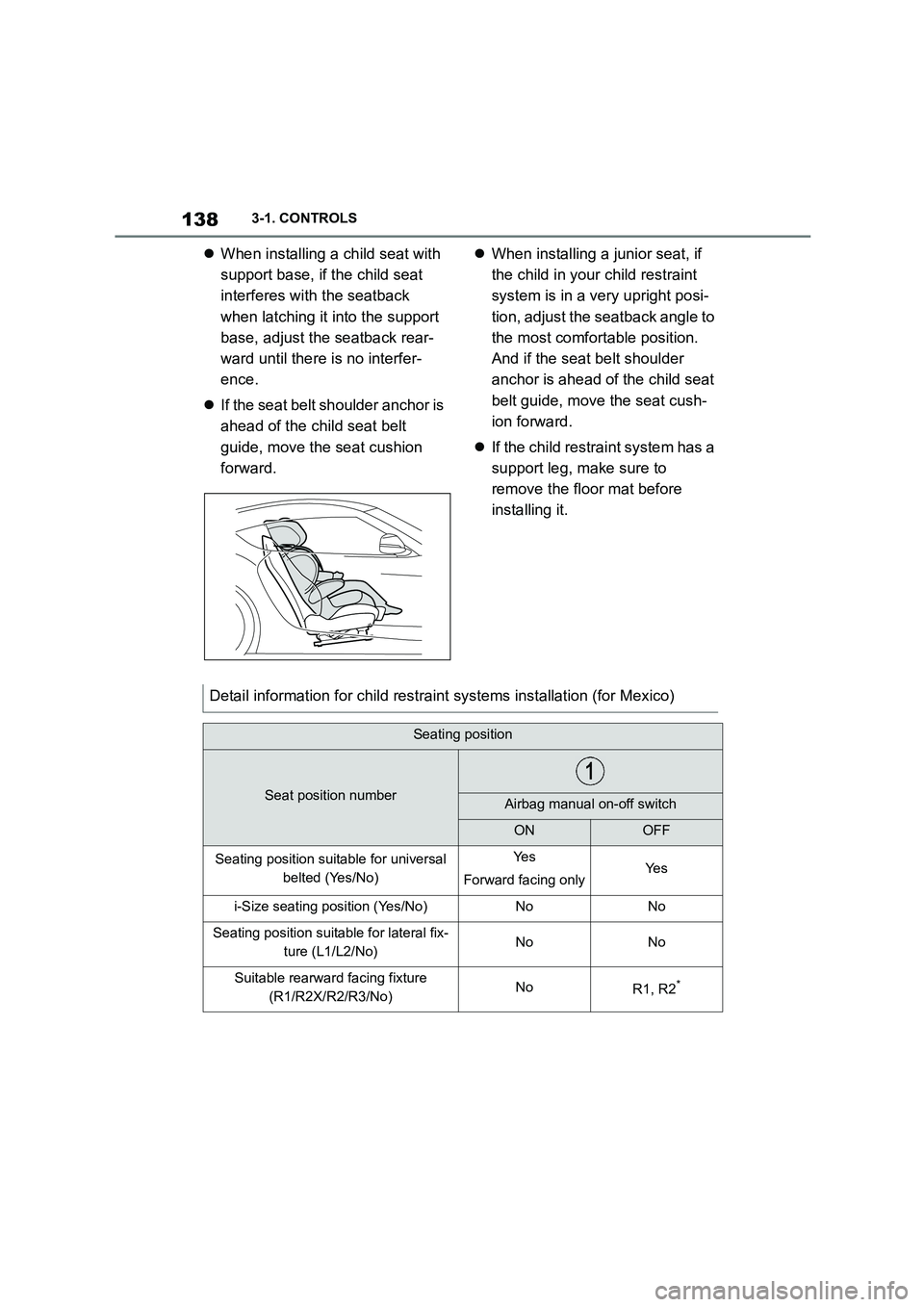
1383-1. CONTROLS
When installing a child seat with
support base, if the child seat
interferes with the seatback
when latching it into the support
base, adjust the seatback rear-
ward until there is no interfer-
ence.
If the seat belt shoulder anchor is
ahead of the child seat belt
guide, move the seat cushion
forward.
When installing a junior seat, if
the child in your child restraint
system is in a very upright posi-
tion, adjust the seatback angle to
the most comfortable position.
And if the seat belt shoulder
anchor is ahead of the child seat
belt guide, move the seat cush-
ion forward.
If the child restraint system has a
support leg, make sure to
remove the floor mat before
installing it.
Detail information for child restraint systems installation (for Mexico)
Seating position
Seat position numberAirbag manual on-off switch
ONOFF
Seating position suitable for universal
belted (Yes/No)
Ye s
Forward facing onlyYe s
i-Size seating position (Yes/No)NoNo
Seating position suitable for lateral fix-
ture (L1/L2/No)NoNo
Suitable rearward facing fixture
(R1/R2X/R2/R3/No)NoR1, R2*
Page 141 of 498
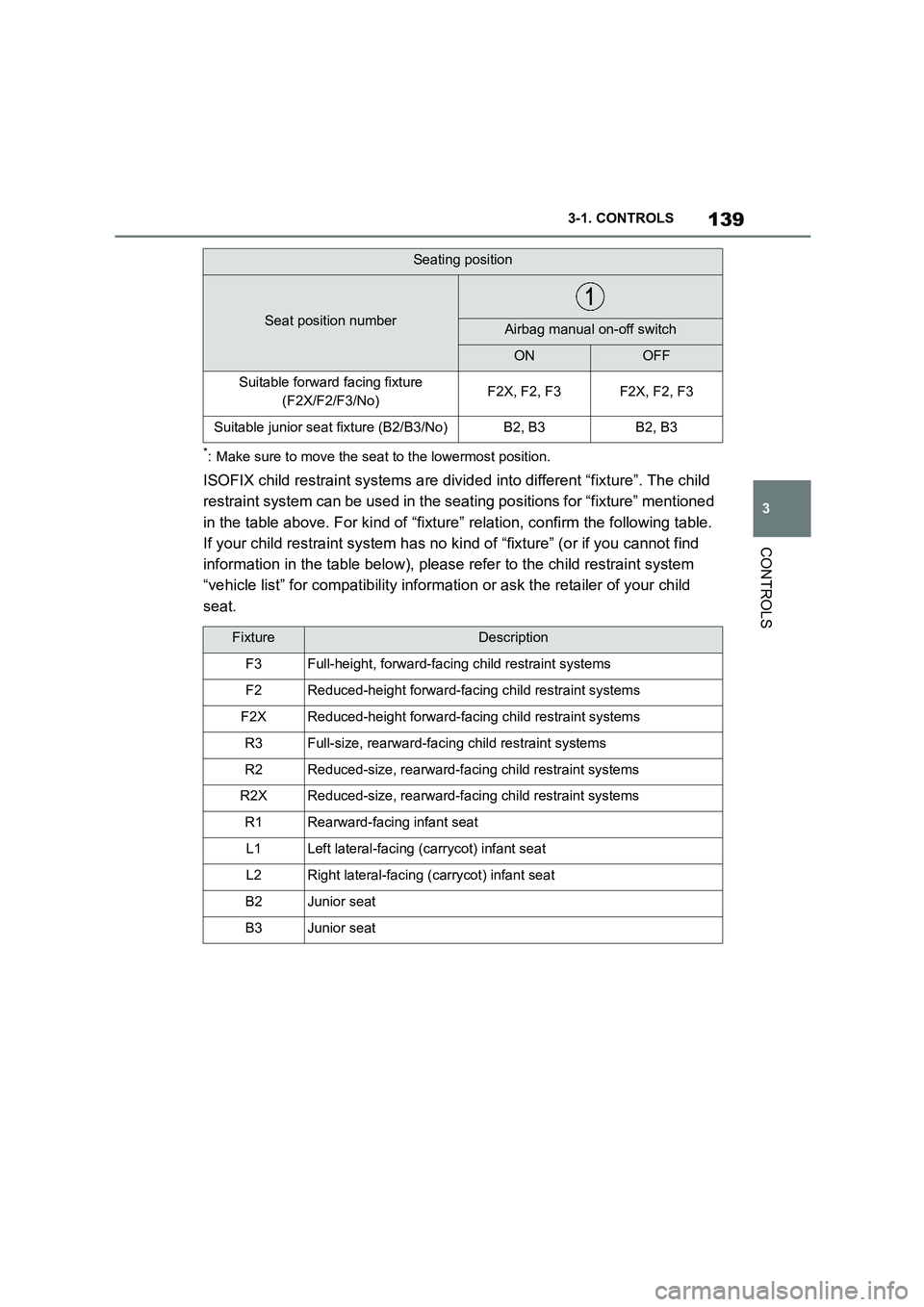
139
3
3-1. CONTROLS
CONTROLS
*: Make sure to move the seat to the lowermost position.
ISOFIX child restraint systems are divid ed into different “fixture”. The child
restraint system can be used in the se ating positions for “fixture” mentioned
in the table above. For kind of “fixtu re” relation, confirm the following table.
If your child restraint system has no ki nd of “fixture” (or if you cannot find
information in the table below), please refer to the child restraint system
“vehicle list” for compatib ility information or ask the retailer of your child
seat.
Suitable forward facing fixture
(F2X/F2/F3/No)F2X, F2, F3F2X, F2, F3
Suitable junior seat fixture (B2/B3/No)B2, B3B2, B3
FixtureDescription
F3Full-height, forward-faci ng child restraint systems
F2Reduced-height forward-facing child restraint systems
F2XReduced-height forward-facing child restraint systems
R3Full-size, rearward-facing child restraint systems
R2Reduced-size, rearward-facing child restraint systems
R2XReduced-size, rearward-facing child restraint systems
R1Rearward-facing infant seat
L1Left lateral-facing (carrycot) infant seat
L2Right lateral-facing (carrycot) infant seat
B2Junior seat
B3Junior seat
Seating position
Seat position numberAirbag manual on-off switch
ONOFF
Page 142 of 498
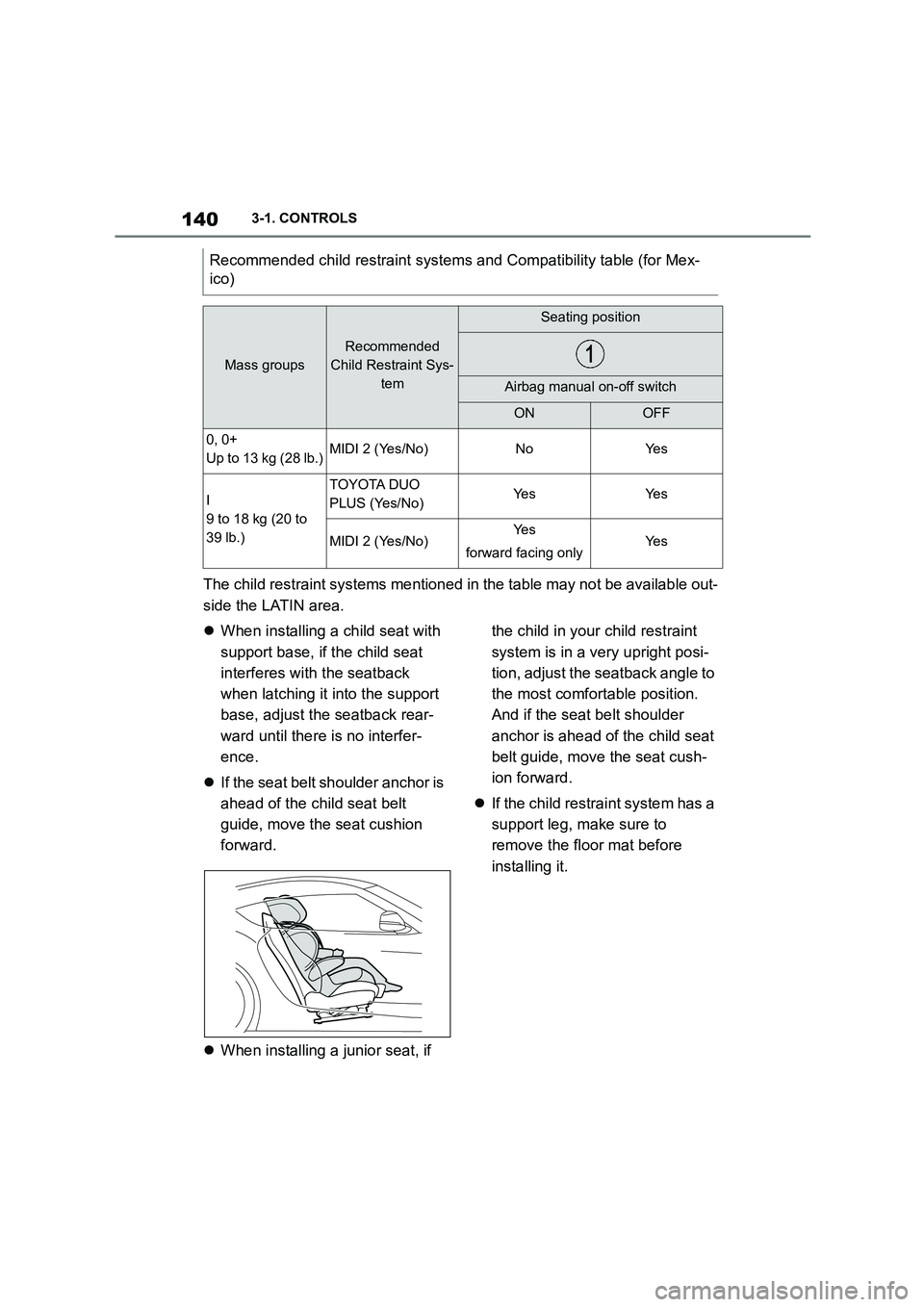
1403-1. CONTROLS
The child restraint systems mentioned in the table may not be available out-
side the LATIN area.
When installing a child seat with
support base, if the child seat
interferes with the seatback
when latching it into the support
base, adjust the seatback rear-
ward until there is no interfer-
ence.
If the seat belt shoulder anchor is
ahead of the child seat belt
guide, move the seat cushion
forward.
When installing a junior seat, if
the child in your child restraint
system is in a very upright posi-
tion, adjust the seatback angle to
the most comfortable position.
And if the seat belt shoulder
anchor is ahead of the child seat
belt guide, move the seat cush-
ion forward.
If the child restraint system has a
support leg, make sure to
remove the floor mat before
installing it.
Recommended child restra int systems and Compatibility table (for Mex-
ico)
Mass groups
Recommended
Child Restraint Sys-
tem
Seating position
Airbag manual on-off switch
ONOFF
0, 0+
Up to 13 kg (28 lb.)MIDI 2 (Yes/No)NoYe s
I
9 to 18 kg (20 to
39 lb.)
TOYOTA DUO
PLUS (Yes/No)Ye sYe s
MIDI 2 (Yes/No)Ye s
forward facing onlyYe s
Page 143 of 498
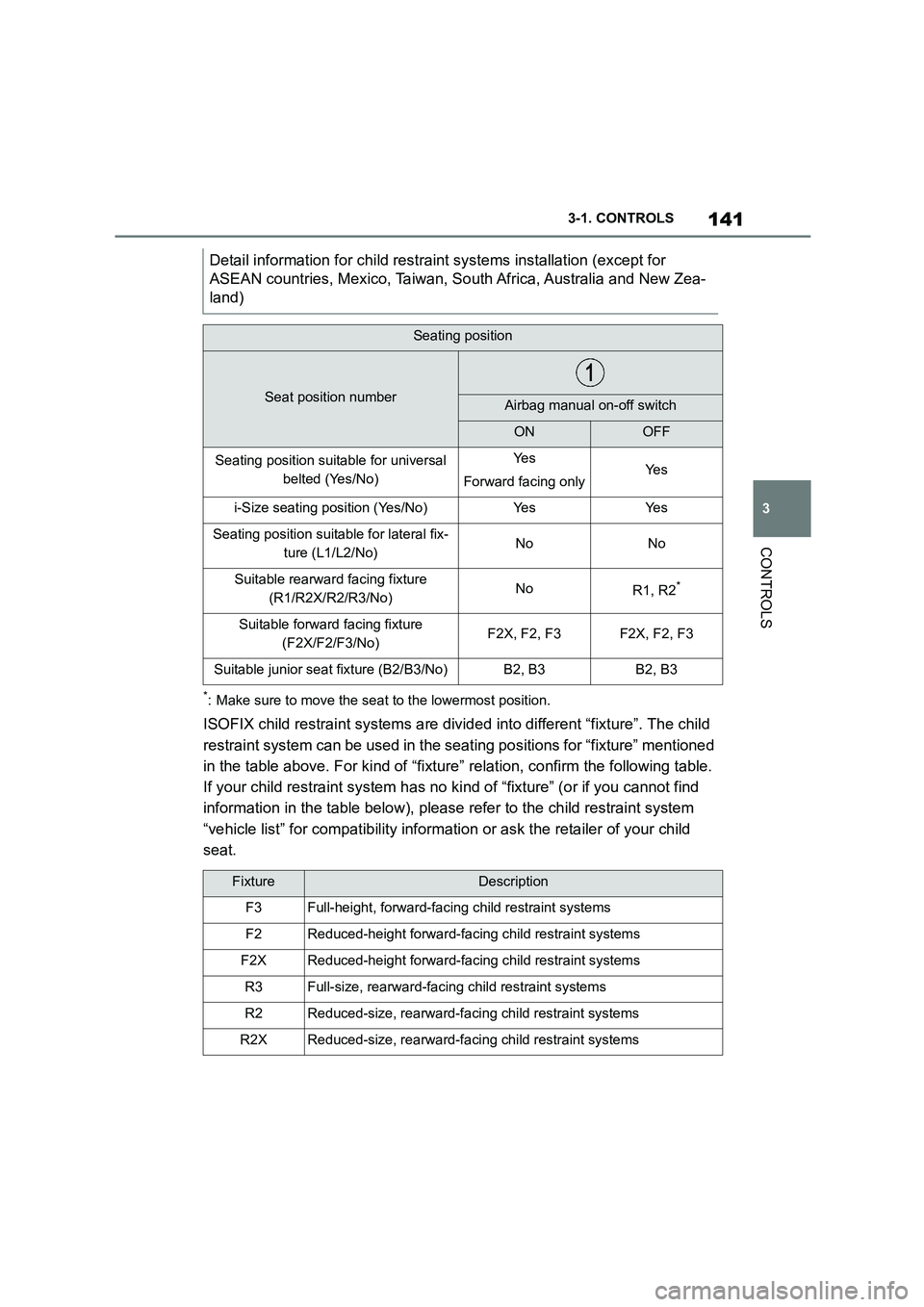
141
3
3-1. CONTROLS
CONTROLS
*: Make sure to move the seat to the lowermost position.
ISOFIX child restraint systems are divid ed into different “fixture”. The child
restraint system can be used in the se ating positions for “fixture” mentioned
in the table above. For kind of “fixtu re” relation, confirm the following table.
If your child restraint system has no ki nd of “fixture” (or if you cannot find
information in the table below), please refer to the child restraint system
“vehicle list” for compatib ility information or ask the retailer of your child
seat.
Detail information for ch ild restraint systems installation (except for
ASEAN countries, Mexico, Taiwan, So uth Africa, Australia and New Zea-
land)
Seating position
Seat position numberAirbag manual on-off switch
ONOFF
Seating position suitable for universal
belted (Yes/No)
Ye s
Forward facing onlyYe s
i-Size seating position (Yes/No)Ye sYe s
Seating position suitable for lateral fix-
ture (L1/L2/No)NoNo
Suitable rearward facing fixture
(R1/R2X/R2/R3/No)NoR1, R2*
Suitable forward facing fixture
(F2X/F2/F3/No)F2X, F2, F3F2X, F2, F3
Suitable junior seat fixture (B2/B3/No)B2, B3B2, B3
FixtureDescription
F3Full-height, forward-faci ng child restraint systems
F2Reduced-height forward-facing child restraint systems
F2XReduced-height forward-facing child restraint systems
R3Full-size, rearward-facing child restraint systems
R2Reduced-size, rearward-facing child restraint systems
R2XReduced-size, rearward-facing child restraint systems
Page 144 of 498
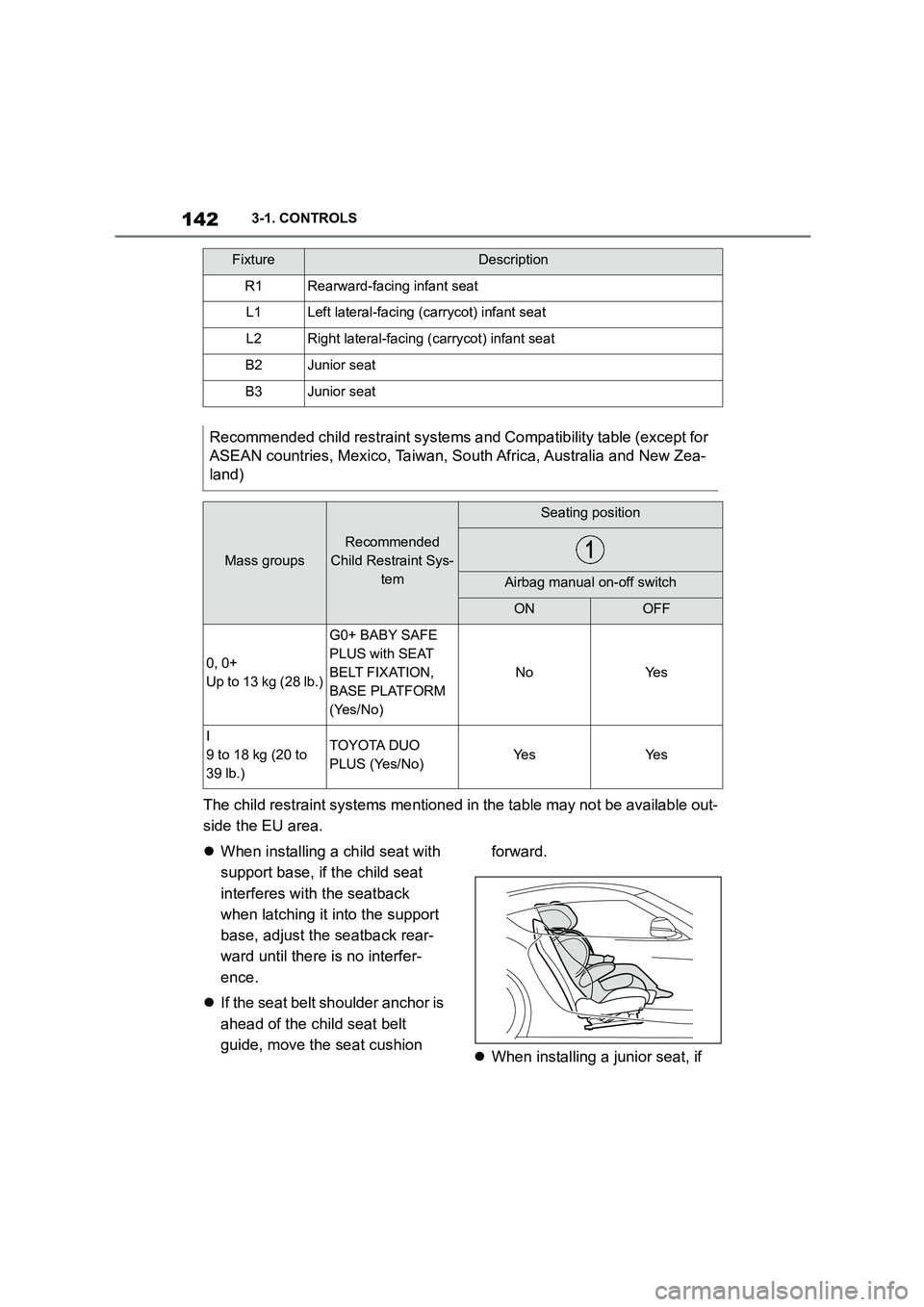
1423-1. CONTROLS
The child restraint systems mentioned in the table may not be available out-
side the EU area.
When installing a child seat with
support base, if the child seat
interferes with the seatback
when latching it into the support
base, adjust the seatback rear-
ward until there is no interfer-
ence.
If the seat belt shoulder anchor is
ahead of the child seat belt
guide, move the seat cushion
forward.
When installing a junior seat, if
R1Rearward-facing infant seat
L1Left lateral-facing (carrycot) infant seat
L2Right lateral-facing (carrycot) infant seat
B2Junior seat
B3Junior seat
Recommended child restraint systems and Compatibility table (except for
ASEAN countries, Mexico, Taiwan, So uth Africa, Australia and New Zea-
land)
Mass groups
Recommended
Child Restraint Sys-
tem
Seating position
Airbag manual on-off switch
ONOFF
0, 0+
Up to 13 kg (28 lb.)
G0+ BABY SAFE
PLUS with SEAT
BELT FIXATION,
BASE PLATFORM
(Yes/No)
NoYe s
I
9 to 18 kg (20 to
39 lb.)
TOYOTA DUO
PLUS (Yes/No)Ye sYe s
FixtureDescription
Page 145 of 498
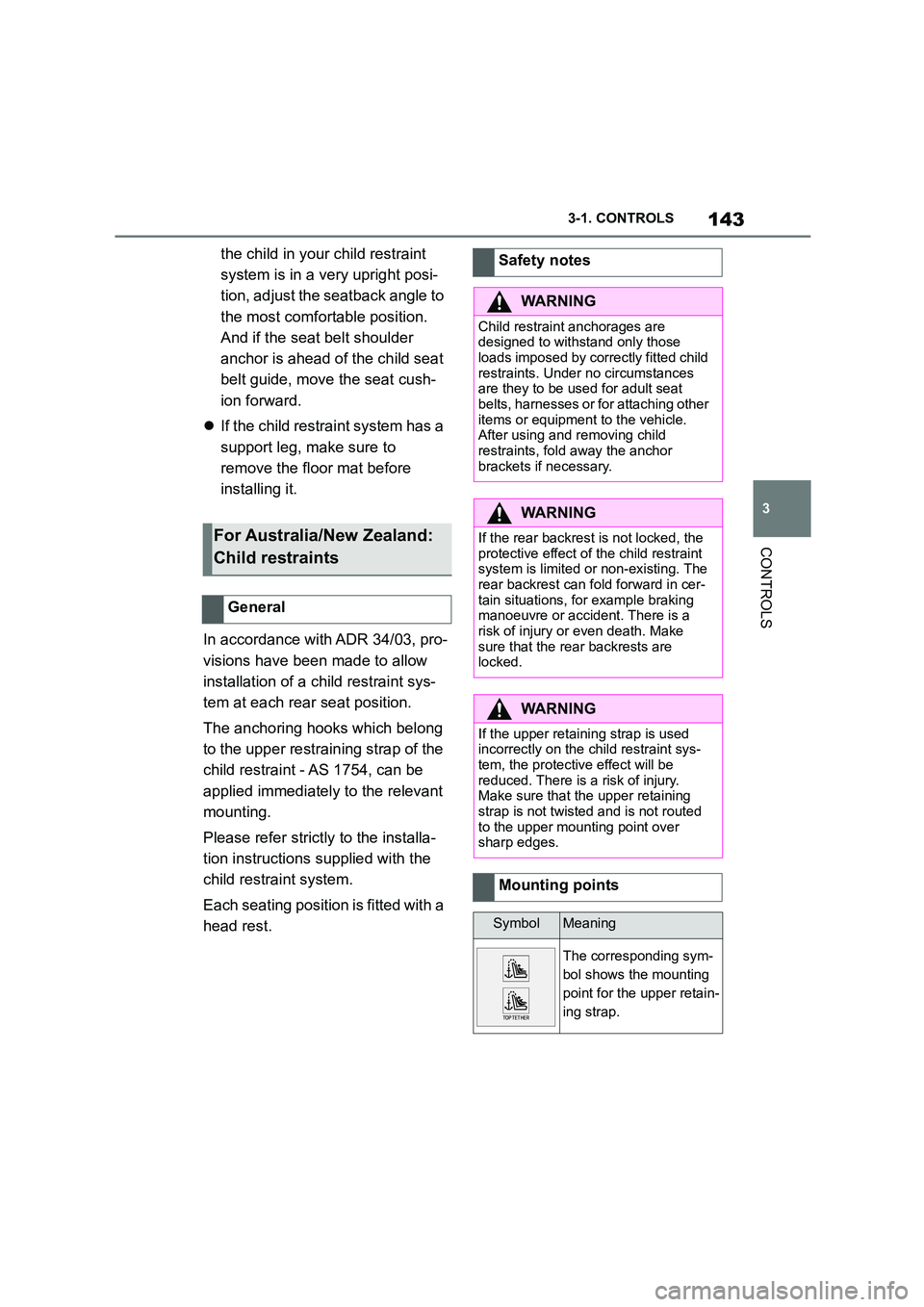
143
3
3-1. CONTROLS
CONTROLS
the child in your child restraint
system is in a very upright posi-
tion, adjust the seatback angle to
the most comfortable position.
And if the seat belt shoulder
anchor is ahead of the child seat
belt guide, move the seat cush-
ion forward.
If the child restraint system has a
support leg, make sure to
remove the floor mat before
installing it.
In accordance with ADR 34/03, pro-
visions have been made to allow
installation of a child restraint sys-
tem at each rear seat position.
The anchoring hooks which belong
to the upper restraining strap of the
child restraint - AS 1754, can be
applied immediately to the relevant
mounting.
Please refer strictly to the installa-
tion instructions supplied with the
child restraint system.
Each seating position is fitted with a
head rest.
For Australia/New Zealand:
Child restraints
General
Safety notes
WA R N I N G
Child restraint anchorages are
designed to withstand only those loads imposed by correctly fitted child
restraints. Under no circumstances
are they to be used for adult seat belts, harnesses or for attaching other
items or equipment to the vehicle.
After using and removing child
restraints, fold away the anchor brackets if necessary.
WA R N I N G
If the rear backrest is not locked, the protective effect of the child restraint
system is limited or non-existing. The
rear backrest can fold forward in cer- tain situations, for example braking
manoeuvre or accident. There is a
risk of injury or even death. Make sure that the rear backrests are
locked.
WA R N I N G
If the upper retaining strap is used incorrectly on the child restraint sys-
tem, the protective effect will be
reduced. There is a risk of injury. Make sure that the upper retaining
strap is not twisted and is not routed
to the upper mounting point over sharp edges.
Mounting points
SymbolMeaning
The corresponding sym-
bol shows the mounting
point for the upper retain-
ing strap.
Page 204 of 498

2023-1. CONTROLS
When severe impact is applied to a
wheel or tire, or the suspension of
the vehicle
When the vehicle is involved in a
side collision in an area away from
the cabin (engine compartment,
luggage compartment, etc.)
When the vehicle is involved in an
offset angle side collision
When a subsequent collision
occurs after a SRS side airbag or
SRS curtain shield airbag has
operated
When only a small impact is
applied to the side of the vehicle
in a collision
When the SRS airbag warning
light is illuminated
When the majority of the initial
force of an impact is applied only
to a door
When a child restraint system is
used on the front passenger seat,
the front and side airbags on the
front passenger side can be deacti-
vated using the key switch for front
The threshold for the SRS side
airbags and SRS curtain shield
airbags to deploy will increase
considerably when
The SRS side airbags and SRS
curtain shield airbags will not
deploy when
Not for Australia/New Zea-
land: Key switch for front
passenger airbags
Principle